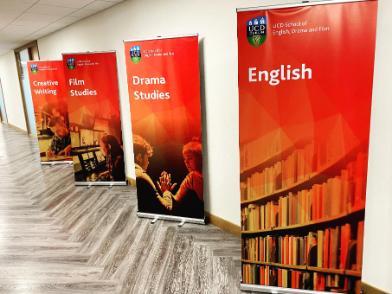DigiRead: How to Read Digitally
Overview

This Learning Enhancement project has been funded through SATLE (Strategic Alignment of Teaching and Learning Enhancement) with the support of the National Forum / HEA.
| PROJECT TITLE: | DigiRead: How to Read Digitally |
|---|---|
| PROJECT COORDINATOR: | Prof Danielle Clarke, School of English, Drama and Film |
| COLLABORATORS: | Ms Jenny Costello, Assoc Prof Elva Johnston, Dr Marta Bustillo |
| TARGET AUDIENCE: | The intention was to investigate student reading practices across the undergraduate cohort; in practice, the students who engaged most extensively were first-year students. One of the conclusions of our project is that advice and guidance about reading and annotation practices should be embedded in the first-year curriculum. |
Background
The context for the project was two-fold. Firstly, given the heavy dependence of humanities’ subjects on reading skill, and strong investment in the teaching of writing, our starting point was that higher order literacy is not a skill that we teach, or assess directly. There is an assumption that students already possess the reading skills they need to succeed at third level, but no evidence as to whether they do or not. Secondly, there has been a wholesale shift to reading texts in digital spaces – these are many and various, from e-readers, to websites, to pdfs, audiobooks – and to a range of different platforms for recording and organising responses, reactions and ideas. In addition, such practices – which for example allow searching, cut and paste, also have implications for academic integrity.
Goals
The project aimed to:
- Improve students’ engagement with course reading and source management
- Ensure that reading is fully accessible and inclusive
- Explore how, as teachers, we can use the affordances of digital reading (and digital tools) to improve learning outcomes
- Provide students with guidance on the pros and cons of different annotation tools and apps
- Give teachers a vocabulary, tools and techniques for teaching higher-level literacy and critical literacy
- Define and classify types of reading and help students and teachers to identify these and select appropriately
- Identify ways to assess reading competence and practice
- Provide students with tools to manage their reading, their time, and to get the most from their reading
Approach
The project was held back from the start by delays in appointing a project manager, and this necessitated several changes of direction. We carried out surveys of both faculty and student, and got excellent responses from both, resulting in a significant body of both qualitative and quantitative data. In the case of the student survey this focussed on what, when, how and where they read, as well as how much they read, and how they made decisions about reading. We also asked them about difficulty, obstacles, and how and if they took notes. The staff survey focussed on (1) perceptions of how much and how effectively students read and (2) what kinds of strategies staff use in the classroom to develop and enhance student reading skills. There was a notable gap between student perceptions of their reading activity, and that of academic staff.
Results
Despite some obstacles, the deliverables aligned quite closely with the original proposal. The main deliverable for students is advice and support on how to incorporate appropriate annotation and information tools for humanities students. Through our surveys, focus groups, workshops and diary tool, we have gathered:
- A dataset with quantitative information about students’ reading habits
- A qualitative set of responses about how, when and why students read (or don’t)
- A resource for students explaining a selection of annotation tools, how to use them, and advantages and limitations of each – training videos/sessions
- Resources for teachers on how to choose appropriate annotation tools for the skills they wish to embed
- A peer-reviewed article in an appropriate HE journal to discuss findings
- A simple diary tool to support students in managing their reading - one key feedback point was that keeping the diary enabled students to be more active and aware of their time.
Some key take-aways were that students prefer to read physical books/pdfs; that students struggle with time management, focus/concentration, lack of guidance on how to read critical material in particular, and that they are keen to improve their reading skills, seeing these as crucial to academic success, but also as critical for their futures: this perception has been sharpened by the increasing presence of AI.
Resources
Our resources will be made available to both key cohorts (staff and students), and the diary tool will, in consultation with the Associate Dean and VP for T&L, be rolled out for first-year students in 2025-26.